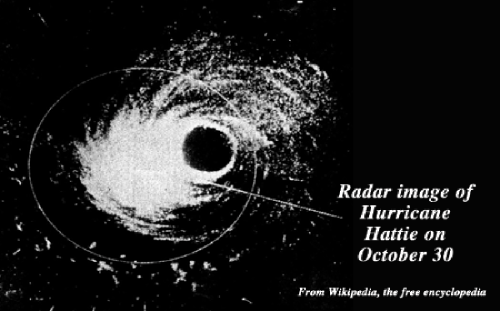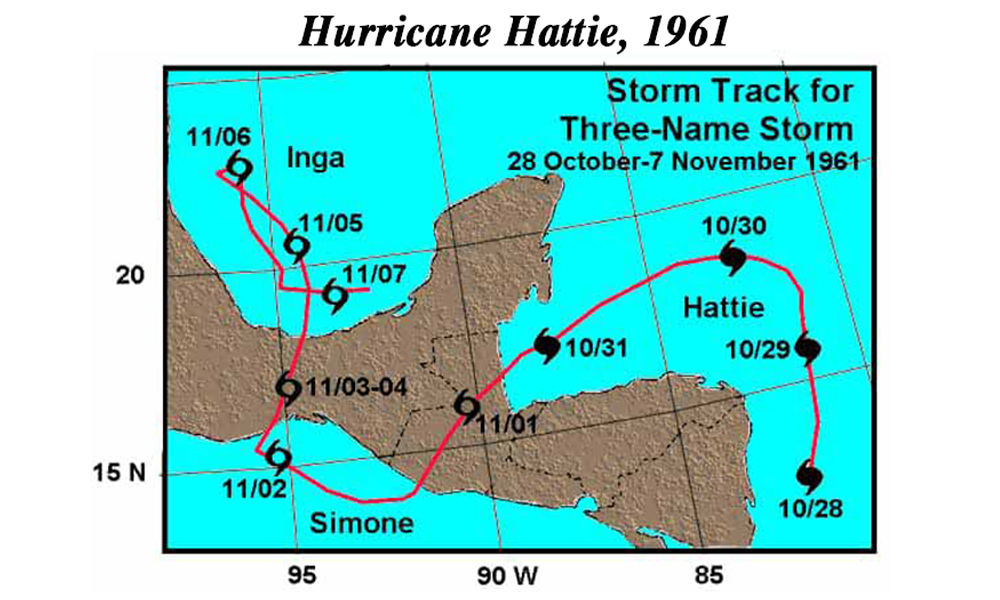by Khaila Gentle
BELIZE CITY, Mon. Oct. 31, 2022
As Belizeans brace for Hurricane Lisa’s landfall, we are reminded of the hurricane that literally reshaped the country some 61 years ago. Hurricane Hattie, one of the strongest and deadliest storms of 1961, made landfall outside Belize City, near Mullins River, on October 31 as a Category 4 storm after having downsized from a Category 5.

The leading newspaper in British Honduras at that time, the Belize Billboard, reported on Saturday, October 28, 1961, that Hattie appeared in the Caribbean 550 miles southwest of Kingston, Jamaica. On the following day, the storm began heading north, but by Tuesday night, at some time around midnight on October 31, the storm had stalled, and then it made an abrupt southwest turn, wreaking havoc on the colony of British Honduras from Belize City (then known just as Belize) down to Stann Creek Town.
“A Hurricane at Halloween,” is what an Amandala article, dated Saturday, November 3, 2018, called that event. And indeed, for the tens of thousands of people living in British Honduras at that time, it was a nightmarish event, to say the least. Even today, some might say that Hurricane Hattie left an indelible mark on Belize.
It was the storm that split Caye Caulker into two, and many also know it as the reason the country’s new capital, Belmopan City, was built. It also prompted residents of British Honduras to begin building their houses out of reinforced concrete.
Hattie is also the reason a vast majority of Belize’s Kriol population began migrating en masse to the United States—a move that would lead to a dramatic change in the demographics of the country, as that ethnic group gradually dwindled from being 50% of the population to the current 24.9%.
With winds of up to 160 miles per hour and gusts of up to 200 mph, Hattie battered the colony from midnight onward. Storm surges reached heights of 13-15 feet, and by the end of it all, most of Belize and Stann Creek had been destroyed. More than 200 persons died that night, with Belize City contributing to almost half of the death toll. Though, admittedly, had there not been any advanced warnings, loss of life would have been much worse. As for property loss, a total of $60 million in damage was estimated—a figure that equates to close to $400 million today. Thousands of persons were left homeless—an effect that would lead to the establishment of Hattieville and Georgetown.
The struggle and hardship caused by Hattie would last for many years. And those who lived through the storm would forever remember those harrowing moments in the early hours of October 31.
Former air traffic controller, Mr. Alejandro Vernon, who was stationed at Puerto Barrios in Guatemala during Hattie, wrote to the Editor of Amandala on Friday, December 8, 2006, recounting his experiences during and after the storm.
“Monday morning of October 31, there was a dead calm in Puerto Barrios,” he said. “The tide was way out. A few birds flew lazily above our Tower. There was news that a hurricane was moving in the Caribbean towards our coast. By 3:00 p.m. a brisk wind developed into strong gusts from 20 to 40 knots. By seven pm, hurricane outer winds were lashing past Roatan, and its center heading straight for Belize.”
By the time the storm had passed, he said, Belize City was under water.
“Belize’s Stanley Field Airport was incommunicado, isolated from Belize City. Telephone lines were down, and the British soldiers from Airport Camp were on the double cutting their way through debris, zinc, fallen trees and huge logs strewn across the road in an effort to reach Belize City,” he added.
Vernon’s wife had been in the Belize Hospital at the time, having undergone surgery two days prior. She and twenty other patients found themselves crammed into the hospital bathroom, listening as wind and waves battered the building.
Hattie would go on to be known as the most powerful hurricane to impact the region until 1998’s Hurricane Mitch. Still, it is rivaled in notoriety perhaps only by the nameless September 10, 1931 hurricane which demolished Belize Town and claimed over 2,000 lives.

